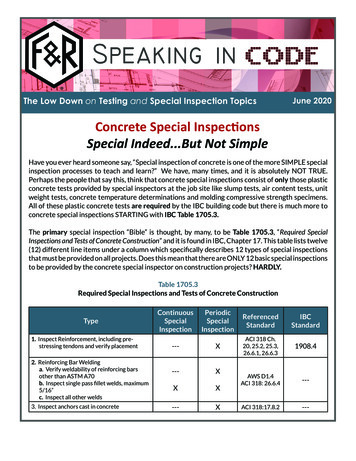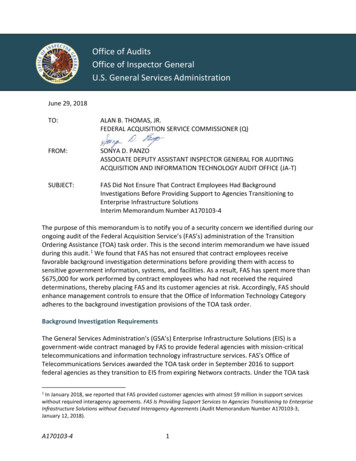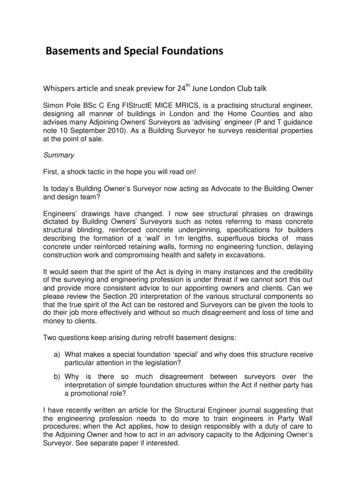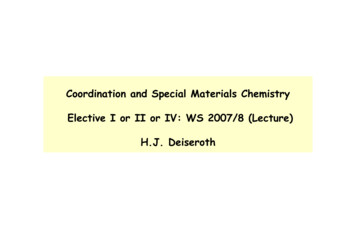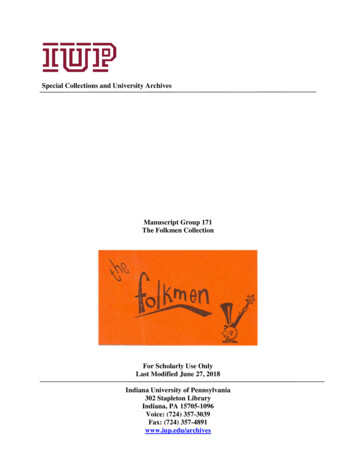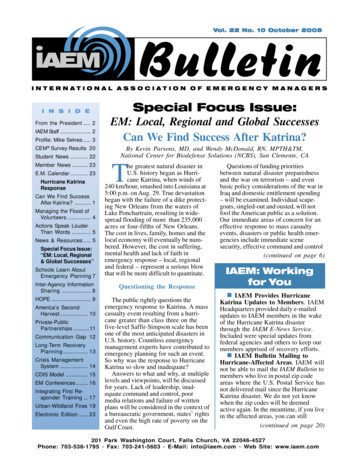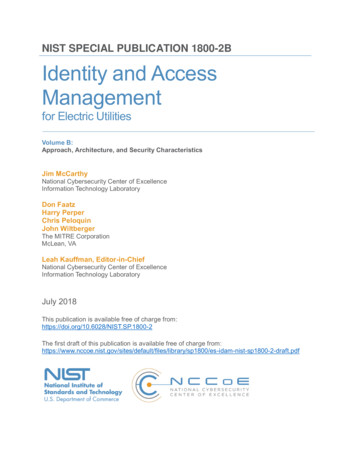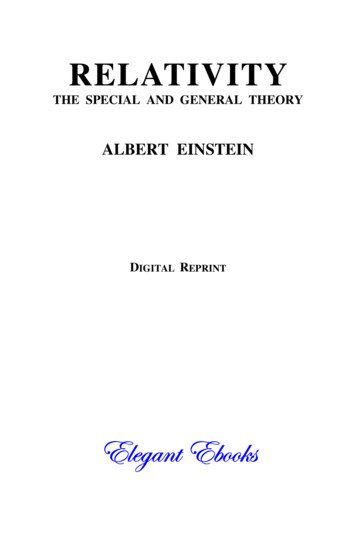
Transcription
RELATIVITYTHE SPECIAL AND GENERAL THEORYALBERT EINSTEINDIGITAL REPRINTElegant Ebooks
COPYRIGHT INFORMATIONBook: Relativity: The Special and General TheoryAuthor: Albert Einstein, 1879–1955First published: 1920The original book is in the public domain in theUnited States. However, since Einstein died in 1955, itmay still be under copyright in many other countries, forexample, those that use the life of the author 60 yearsor life 70 years for the duration of copyright. Readersoutside the United States should check their owncountries’ copyright laws to be certain they can legallydownload this ebook. The Online Books Page has an FAQwhich gives a summary of copyright durations for manyother countries, as well as links to more official sources.This PDF ebook wascreated by José Menéndez.NOTE ON THE TEXTThe text used in this ebook is from the first Englishtranslation, published in 1920, of Über die spezielle unddie allgemeine Relativitätstheorie. A few misprints in theoriginal text have been corrected, but to preserve all of thebook, the original misprints are included in footnotesenclosed in square brackets and signed “J.M.”In addition, the line breaks and pagination of the originalbook have been reproduced, and the PDF’s page numbersare linked to page images of the book from the GoogleBooks Library Project for easy comparison. Please note:Google’s images may not be available to people outsidethe U.S. and may be unavailable to U.S. residents at times.Retaining the original pagination made it possible toinclude a fully functional (clickable) copy of the originalindex.
R E L AT I V I T YTHE SPECIAL AND GENERAL THEORYBYALBERT EINSTEIN, Ph.D.PROFESSOR OF PHYSICS IN THE UNIVERSITY OF BERLINTRANSLATED BYROBERT W. LAWSON, M.Sc.UNIVERSITY OF SHEFFIELDNEW YORKHENRY HOLT AND COMPANY1920
COPYRIGHT, 1920BYHENRY HOLT AND COMPANY
PREFACETHE present book is intended, as far as possible, to give an exact insight into thetheory of Relativity to those readers who,from a general scientific and philosophical pointof view, are interested in the theory, but who arenot conversant with the mathematical apparatus 1of theoretical physics. The work presumes astandard of education corresponding to that of auniversity matriculation examination, and, despite the shortness of the book, a fair amountof patience and force of will on the part of thereader. The author has spared himself no painsin his endeavour to present the main ideas in thesimplest and most intelligible form, and on the1The mathematical fundaments of the special theory of relativity are to be found in the original papers of H. A. Lorentz, A.Einstein, H. Minkowski,* published under the title Das Relativitätsprinzip (The Principle of Relativity) in B. G. Teubner’s collectionof monographs Fortschritte der mathematischen Wissenschaften (Advances in the Mathematical Sciences), also in M. Laue’s exhaustivebook Das Relativitäts prinzip — published by Friedr. Vieweg & Son,Braunschweig. The general theory of relativity, together with thenecessary parts of the theory of invariants, is dealt with in theauthor’s book Die Grundlagen der allgemeinen Relativitätstheorie(The Foundations of the General Theory of Relativity) — Joh.Ambr. Barth, 1916; this book assumes some familiarity with thespecial theory of relativity.v[* Minkowski‘ — J.M.]
viRELATIVITYwhole, in the sequence and connection in whichthey actually originated. In the interest ofclearness, it appeared to me inevitable that Ishould repeat myself frequently, without payingthe slightest attention to the elegance of thepresentation. I adhered scrupulously to theprecept of that brilliant theoretical physicist,L. Boltzmann, according to whom matters ofelegance ought to be left to the tailor and to thecobbler. I make no pretence of having withheld from the reader difficulties which are inherent to the subject. On the other hand, I havepurposely treated the empirical physical foundations of the theory in a “step-motherly” fashion,so that readers unfamiliar with physics may notfeel like the wanderer who was unable to see theforest for trees. May the book bring some onea few happy hours of suggestive thought!A. EINSTEINDecember, 1916NOTE TO THE THIRD EDITIONIN the present year (1918) an excellent anddetailed manual on the general theory ofrelativity, written by H. Weyl, was published by the firm Julius Springer (Berlin). Thisbook, entitled Raum — Zeit — Materie (Space —Time — Matter), may be warmly recommendedto mathematicians and physicists.
BIOGRAPHICAL NOTEALBERT EINSTEIN is the son of GermanJewish parents. He was born in 1879 inthe town of Ulm, Würtemberg, Germany.His schooldays were spent in Munich, where heattended the Gymnasium until his sixteenth year.After leaving school at Munich, he accompanied hisparents to Milan, whence he proceeded to Switzerland six months later to continue his studies.From 1896 to 1900 Albert Einstein studiedmathematics and physics at the Technical HighSchool in Zurich, as he intended becoming asecondary school (Gymnasium) teacher. Forsome time afterwards he was a private tutor,and having meanwhile become naturalised, heobtained a post as engineer in the Swiss PatentOffice in 1902, which position he occupied till 1909.The main ideas involved in the most importantof Einstein’s theories date back to this period.Amongst these may be mentioned: The SpecialTheory of Relativity, Inertia of Energy, Theory ofthe Brownian Movement, and the Quantum-Lawof the Emission and Absorption of Light (1905).These were followed some years later by thevii
viiiRELATIVITYTheory of the Specific Heat of Solid Bodies, and thefundamental idea of the General Theory of Relativity.During the interval 1909 to 1911 he occupiedthe post of Professor Extraordinarius at theUniversity of Zurich, afterwards being appointedto the University of Prague, Bohemia, where heremained as Professor Ordinarius until 1912.In the latter year Professor Einstein accepted asimilar chair at the Polytechnikum, Zurich, andcontinued his activities there until 1914, whenhe received a call to the Prussian Academy ofScience, Berlin, as successor to Van’t Hoff.Professor Einstein is able to devote himselffreely to his studies at the Berlin Academy, andit was here that he succeeded in completing hiswork on the General Theory of Relativity (1915–17). Professor Einstein also lectures on variousspecial branches of physics at the University ofBerlin, and, in addition, he is Director of theInstitute * for Physical Research of the KaiserWilhelm Gesellschaft.Professor Einstein has been twice married.His first wife, whom he married at Berne in 1903,was a fellow-student from Serbia. There weretwo sons of this marriage, both of whom are living in Zurich, the elder being sixteen years of age.Recently Professor Einstein married a widowedcousin, with whom he is now living in Berlin.R. W. L.[* Institnte — J.M.]
TRANSLATOR’S NOTEIN presenting this translation to the Englishreading public, it is hardly necessary for meto enlarge on the Author’s prefatory remarks,except to draw attention to those additions to thebook which do not appear in the original.At my request, Professor Einstein kindly supplied me with a portrait of himself, by one ofGermany’s most celebrated artists. Appendix III,on “The Experimental Confirmation of the General Theory of Relativity,” has been writtenspecially for this translation. Apart from thesevaluable additions to the book, I have includeda biographical note on the Author, and, at theend of the book, an Index and a list of Englishreferences to the subject. This list, which ismore suggestive than exhaustive, is intended asa guide to those readers who wish to pursue thesubject farther.I desire to tender my best thanks to my colleagues Professor S. R. Milner, D.Sc., and Mr.W. E. Curtis, A.R.C.Sc., F.R.A.S., also to myfriend Dr. Arthur Holmes, A.R.C.Sc., F.G.S.,ix
xRELATIVITYof the Imperial College, for their kindness inreading through the manuscript, for helpfulcriticism, and for numerous suggestions. I owean expression of thanks also to Messrs. Methuenfor their ready counsel and advice, and for thecare they have bestowed on the work during thecourse of its publication.ROBERT W. LAWSONTHE PHYSICS LABORATORYTHE UNIVERSITY OF SHEFFIELDJune 12, 1920
CONTENTSPART ITHE SPECIAL THEORY OF RELATIVITYPAGEI. Physical Meaning of Geometrical Propositions . . . . . . . . . . . . . .1II. The System of Co-ordinates . . . . . .5III. Space and Time in Classical Mechanics .9IV. The Galileian System of Co-ordinates . .12V. The Principle of Relativity (in the Restricted Sense) . . . . . . . . . . .14VI. The Theorem of the Addition of Velocitiesemployed in Classical Mechanics . . .19VII. The Apparent Incompatibility of the Lawof Propagation of Light with the Principle of Relativity . . . . . . . . .21VIII. On the Idea of Time in Physics . . . .25IX. The Relativity of Simultaneity . . . . .30X. On the Relativity of the Conception ofDistance . . . . . . . . . . . . .34XI. The Lorentz Transformation . . . . . .36XII. The Behaviour of Measuring-Rods andClocks in Motion . . . . . . . . . .42xi
xiiRELATIVITYPAGEXIII. Theorem of the Addition of Velocities.The Experiment of Fizeau . . . . . .45XIV. The Heuristic Value of the Theory ofRelativity . . . . . . . . . . . . .50XV. General Results of the Theory . . . . .52XVI. Experience and the Special Theory ofRelativity * . . . . . . . . . . . . .58XVII. Minkowski’s Four-dimensional Space . .65PART IITHE GENERAL THEORY OF RELATIVITYXVIII. Special and General Principle of Relativity69XIX. The Gravitational Field . . . . . . . .74XX. The Equality of Inertial and GravitationalMass as an Argument for the GeneralPostulate of Relativity . . . . . . .78XXI. In what Respects are the Foundations ofClassical Mechanics and of the SpecialTheory of Relativity unsatisfactory? .84†XXII. A Few Inferences from the General Theoryof Relativity . . . . . . . . . . . .87XXIII. Behaviour of Clocks and Measuring-Rodson a Rotating Body of Reference . . .93XXIV. Euclidean and Non-Euclidean Continuum98XXV. Gaussian Co-ordinates . . . . . . . . 103XXVI. The Space-time Continuum of the SpecialTheory of Relativity considered as aEuclidean Continuum . . . . . . . .108[* Relativ ty — J.M.][† “Theory” was changed to “Principle” in later editions. — J.M.]
CONTENTSxiiiPAGEXXVII. The Space-time Continuum of the GeneralTheory of Relativity is not a EuclideanContinuum . . . . . . . . . . . .111XXVIII. Exact Formulation of the General Principle of Relativity . . . . . . . . .115XXIX. The Solution of the Problem of Gravitation on the Basis of the GeneralPrinciple of Relativity . . . . . . .119PART IIICONSIDERATIONS ON THE UNIVERSEAS A WHOLEXXX. Cosmological Difficulties of Newton’sTheory . . . . . . . . . . . . . .125XXXI. The Possibility of a “Finite” and yet“Unbounded” Universe . . . . . . .128XXXII. The Structure of Space according to theGeneral Theory of Relativity . . . .135APPENDICESI. Simple Derivation of the Lorentz Transformation . . . . . . . . . . . . . . . . 139II. Minkowski’s Four-dimensional Space (“World”)[Supplementary to Section XVII.] . . . . 146III. The Experimental Confirmation of the GeneralTheory of Relativity . . . . . . . . . .(a) Motion of the Perihelion of Mercury . .(b) Deflection of Light by a GravitationalField . . . . . . . . . . . . . . .(c) Displacement of Spectral Lines towardsthe Red . . . . . . . . . . . . .BIBLIOGRAPHY148150152155. . . . . . . . . . . . . . . . 161INDEX . . . . . . . . . . . . . . . . . . . .165
RELATIVITYPART ITHE SPECIAL THEORY OF RELATIVITYIPHYSICAL MEANING OF GEOMETRICALPROPOSITIONSIN your schooldays most of you who read thisbook made acquaintance with the noble building of Euclid’s geometry, and you remember— perhaps with more respect than love — themagnificent structure, on the lofty staircase ofwhich you were chased about for uncountedhours by conscientious teachers. By reason ofyour past experience, you would certainly regardevery one with disdain who should pronounceeven the most out-of-the-way proposition of thisscience to be untrue. But perhaps this feeling ofproud certainty would leave you immediately ifsome one were to ask you: “What, then, do youmean by the assertion that these propositions aretrue?” Let us proceed to give this question alittle consideration.Geometry sets out from certain conceptions suchas “plane,” “point,” and “straight line,” with1
2SPECIAL THEORY OF RELATIVITYwhich we are able to associate more or less definite ideas, and from certain simple propositions(axioms) which, in virtue of these ideas, we areinclined to accept as “true.” Then, on the basisof a logical process, the justification of which wefeel ourselves compelled to admit, all remainingpropositions are shown to follow from those axioms,i.e. they are proven. A proposition is then correct(“true”) when it has been derived in the recognised manner from the axioms. The question ofthe “truth” of the individual geometrical propositions is thus reduced to one of the “truth” ofthe axioms. Now it has long been known thatthe last question is not only unanswerable by themethods of geometry, but that it is in itself entirely without meaning. We cannot ask whetherit is true that only one straight line goes throughtwo points. We can only say that Euclidean geometry deals with things called “straight lines,”to each of which is ascribed the property of beinguniquely determined by two points situated on it.The concept “true” does not tally with theassertions of pure geometry, because by the word“true” we are eventually in the habit of designating always the correspondence with a “real”object; geometry, however, is not concerned withthe relation of the ideas involved in it to objectsof experience, but only with the logical connectionof these ideas among themselves.
GEOMETRICAL PROPOSITIONS3It is not difficult to understand why, in spite ofthis, we feel constrained to call the propositions ofgeometry “true
This PDF ebook was created by José Menéndez. NOTE ON THE TEXT The text used in this ebook is from the first English translation, published in 1920, of Über die spezielle und die allgemeine Relativitätstheorie. A few misprints in the original text have been corrected, but to preserve all of the book, the original misprints are included in footnotes enclosed in square brackets and signed .


